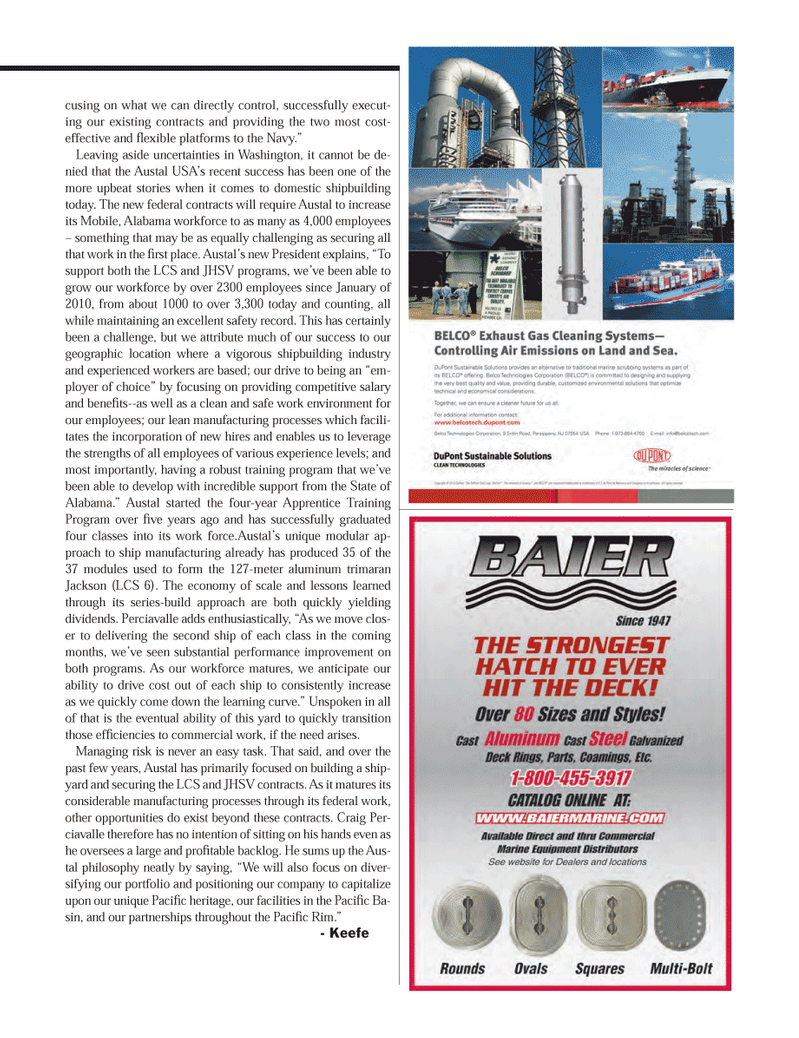
Page 29: of Maritime Logistics Professional Magazine (Q1 2013)
Maritime Risk
Read this page in Pdf, Flash or Html5 edition of Q1 2013 Maritime Logistics Professional Magazine
cusing on what we can directly control, successfully execut- ing our existing contracts and providing the two most cost- effective and ß exible platforms to the Navy.Ó Leaving aside uncertainties in Washington, it cannot be de- nied that the Austal USAÕs recent success has been one of the more upbeat stories when it comes to domestic shipbuilding today. The new federal contracts will require Austal to increase its Mobile, Alabama workforce to as many as 4,000 employees Ð something that may be as equally challenging as securing all that work in the Þ rst place. AustalÕs new President explains, ÒTo support both the LCS and JHSV programs, weÕve been able to grow our workforce by over 2300 employees since January of 2010, from about 1000 to over 3,300 today and counting, all while maintaining an excellent safety record. This has certainly been a challenge, but we attribute much of our success to our geographic location where a vigorous shipbuilding industry and experienced workers are based; our drive to being an Òem- ployer of choiceÓ by focusing on providing competitive salary and beneÞ ts--as well as a clean and safe work environment for our employees; our lean manufacturing processes which facili- tates the incorporation of new hires and enables us to leverage the strengths of all employees of various experience levels; and most importantly, having a robust training program that weÕve been able to develop with incredible support from the State of Alabama.Ó Austal started the four-year Apprentice Training Program over Þ ve years ago and has successfully graduated four classes into its work force.AustalÕs unique modular ap- proach to ship manufacturing already has produced 35 of the 37 modules used to form the 127-meter aluminum trimaran Jackson (LCS 6). The economy of scale and lessons learned through its series-build approach are both quickly yielding dividends. Perciavalle adds enthusiastically, ÒAs we move clos- er to delivering the second ship of each class in the coming months, weÕve seen substantial performance improvement on both programs. As our workforce matures, we anticipate our ability to drive cost out of each ship to consistently increase as we quickly come down the learning curve.Ó Unspoken in all of that is the eventual ability of this yard to quickly transition those efÞ ciencies to commercial work, if the need arises. Managing risk is never an easy task. That said, and over the past few years, Austal has primarily focused on building a ship- yard and securing the LCS and JHSV contracts. As it matures its considerable manufacturing processes through its federal work, other opportunities do exist beyond these contracts. Craig Per- ciavalle therefore has no intention of sitting on his hands even as he oversees a large and proÞ table backlog. He sums up the Aus- tal philosophy neatly by saying, ÒWe will also focus on diver- sifying our portfolio and positioning our company to capitalize upon our unique PaciÞ c heritage, our facilities in the PaciÞ c Ba- sin, and our partnerships throughout the PaciÞ c Rim.Ó - KeefeMP #1 18-33.indd 29MP #1 18-33.indd 292/25/2013 10:13:01 AM2/25/2013 10:13:01 AM

 28
28

 30
30
